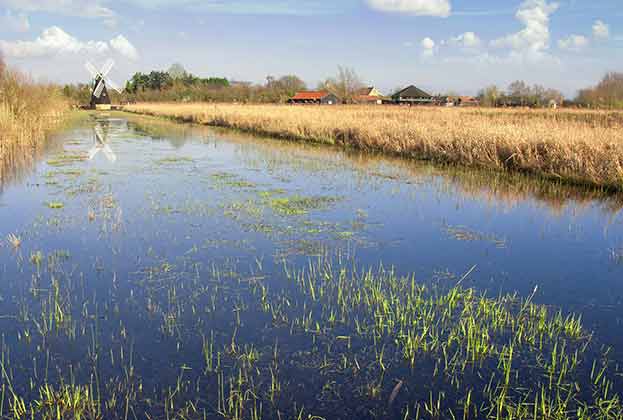Early-stage investment trends signal the type of commercial space that Cambridge will need in the future
Recent investment trends
When adjusted for population size, the Global Innovation Index (GII) ranks Cambridge as the number one innovative ecosystem in the world. Early-stage investment trends suggest that in the future, the economy of the city will become even more weighted towards knowledge-intensive industries, with important consequences for the types of commercial space occupiers will be seeking.
The economic structure of the Cambridge region has attracted high level of investment in both early-stage and more established companies. Most investment has been venture capital (VC), but there has been significant capital-related “exit” events, including mergers and acquisitions and Initial Public Offerings. Companies completing these significant capital events stretch across all innovative and scientific sub-sectors, creating demand for additional laboratory and office space in Cambridge in the future, most likely as a result of headcount growth in the short term.
The economic structure of the Cambridge region has attracted high levels of investment in both early stage and more established companies
Steven Lang, Director, Offices & Life Sciences Commercial Research
The last decade (2014–2023) has seen Cambridgeshire companies complete on nearly £100bn of capital-raising events. Of this total, Healthcare and Information Technology (IT) companies account for 85% of the total capital raised.
Looking at the VC investment in particular can help to understand the IT and healthcare (life sciences) story in more detail. The ‘drug discovery’, ‘surgical devices’ and ‘biotechnology’ sub-sectors have dominated VC raises. This has driven the need for laboratory space and commercial property with higher technical specification overall.
The leading organisations driving investment in terms of monetary value include Cambridge Innovation Capital (CIC), Tencent, CPP Investments and GE Healthcare, illustrating the global nature of the capital coming to Cambridge companies. Across the most prolific investors, there is a much more localism, with the leading three investors including University of Cambridge Seed Funds (Cambridge Enterprise), Cambridge Angels and University of Cambridge Enterprise Fund (Parkwalk Advisors). These investors will be driving growth at smaller, often start-up, scale.
Where next?
The pertinent question for the commercial property markets is which sectors will continue to dominate and which sectors are the emerging “ones to watch”? Since 2016, Savills has reviewed the emerging companies in Cambridgeshire within the ‘buzzword’ sectors. In total, around £900m of capital has been raised by companies based in Cambridgeshire.
The rise of quantum computing is very clear, accounting for nearly 30% of capital raised. For this sector, laboratory-type space (dry labs) would be required, but not with the same air circulation or extraction requirements for wet laboratories for pharma. The same is true for the next highest sector, Medical Robotics. The crossover between artificial intelligence (AI) and the life science sector is emerging strongly with ‘AI-Powered Drug Discovery’ growing on the global stage at a fast pace. This will be a key sub-sector for Cambridge going forward.
A rapidly emerging sector, with huge potential for growth, is food and nutrition. Cambridge’s existing strengths in R&D for life sciences is increasingly important for the food sector, with a focus on preventative interventions for human health. Currently, food sector investment is dominated by ‘Indoor Farming’, comprising just over 10% of all VC investment in Cambridgeshire. But in the coming years, there is potential for significant expansion from the ‘Clean Meat, Cellular Agriculture’ and ‘AI in Foodtech’ sub-sectors. These sectors only comprise 4% of investment since 2016, but will grow by benefiting from a strong academic presence and links with traditional life sciences.
Space and location requirements
The high concentration of companies within Cambridge illustrates that co-location and sectoral clustering is a driver of investment. Future demand will be high for new space within close proximity to these established clusters.
Smaller start-up floorspace, grow-on, wet/dry laboratory and corporate offices will have to be delivered to accommodate the anticipated growth for the wider Cambridge region. For the wet laboratory market, there is an emerging trend of floorspace being fitted out for the smaller companies who do not want to spend hard-earned VC money on fit-out and will have a much shorter lead-in time requirement to occupation.
For the life sciences, the demand is for wet laboratory space. The need for this type of laboratory space for discovery and innovation will remain in the medium term. However, as AI becomes an increasingly powerful tool in this sector, power resilience and secure data storage will likely move further up the specification wish list.
For knowledge-intensive workers, there is a need to deliver commercial floorspace in both city centre and out-of-city locations, mainly science/technology parks. There is a growing shift towards urban locations for science and innovative sub-sectors, with access to public transport hubs becoming a key driver for younger employees.
The delivery of appropriate size and quantum of industrial-related floorspace is vital to deliver and support a strong ecosystem in Cambridge and surrounds
Steven Lang, Director, Offices & Life Sciences Commercial Research
For occupiers, more central, city centre and edge-of-city developments will provide the most appropriate commercial floorspace stock – something that has not been delivered at scale in the recent past. Providing this type of floorspace will draw additional occupiers to the city. However, within the context of ‘good growth’, the newly emerging innovative locations, often as ‘districts’, must acknowledge, incorporate and deliver a direct positive impact for the wider community.
Looking away from the office and laboratory market, the delivery of appropriate size and quantum of industrial-related floorspace is vital to deliver and support a strong ecosystem in Cambridge and surrounds. Echoing global trends in R&D, space is needed not just for research, but also for the development and delivery of ‘discovery’. Mid-tech will be an important commercial sub-sector to maintain in quantity (including warehousing and advanced/light manufacturing). This sub-sector has lower occupier and employment density when compared to laboratories and offices. This means there are fewer workers on-site and it is less reliant on being centrally located near urban areas or near public transport, instead requiring easy access to major road and motorway networks.
Read the articles within Spotlight: Good growth for Cambridge below.
.jpg)

